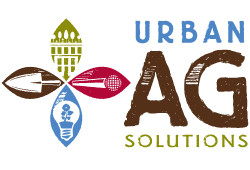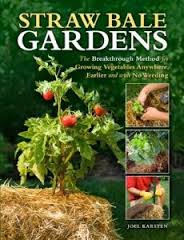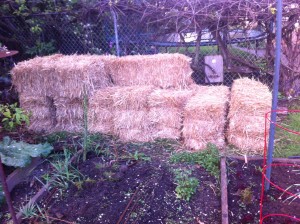Ye olde humble staw bale….once the province of the barnyard animals, but now shifting toward housing and gardening uses.
Some years ago I used to walk past a construction site in my neighborhood where, after the work was completed, a couple straw bales got left behind on the neighboring empty lot. I eyed those bales with each passing and started to wonder whether they would support plant life. I knew from past experience that a straw bale, once wet, becomes a marvelous sponge, and, indeed, a good soaking will “spoil” the straw, that is, it will substitute water for dead air space. It is the air space from the tubular stalks of grains like wheat and oats which makes straw insulative, and thus good animal bedding. Indeed the whole raison d’etre of straw until recently was bedding for animals. Then sustainable builders got a hold of it and made it into super-insulative, sculptural building walls, and now we gardeners are having our day with it as well.
But back, for a moment, to my construction site. On one of my walks past, having extra starts at my disposal, I decided that I would plant a cucumber in one of the bales and commit to bringing some water by on a regular basis. I don’t think I gave much thought to the nutrient issue, except to vaguely surmise that since I had seen straw bales compost, I guessed that they would eventually give up their goods to whatever I planted atop. Foreshadowing hint: vague surmisings usually don’t yield good results.
Well, that little cuke started off alright, but after about 2 weeks, it seemed to run out of steam, and, despite regular watering, eventually croaked. My interest in straw-bale gardening waned (but unlike the cuke, did not entirely croak), though I hadn’t thought much about it until I picked up a book last year entitled “Straw Bale Gardening”.
Here’s the book. It’s by Joel Karsten. Nice work, Joel, you were two important ideas ahead of me!
Perusing the book re-awakened my curiosity and alerted me to two important steps that I had failed to follow to ensure success: the need to initially soak the bale through and the need to introduce soluble nitrogen into the bale to initiate the composting (aka nutrient release) sequence. Armed with this knowledge, I was ready to act.
I called up the nearest shop that I knew had unsprayed straw, in this case City Farm in St. Johns, and had them deliver 1o bales at the somewhat spendy price of $12 each. But as soon as I received them, I knew it was the right decision. I put them up against a fence and – BOOM! – I had an instant bed where none had existed before. Had I had only asphalt on my lot- BOOM! – with straw bales I’d have had a bed. Had I but poor, gravelly, tree-root-robbed soil – BOOM! – with straw bales I’d have gotten a new lease on my gardening life. Had I had a need for a temporary garden to impress friends, confound enemies, establish credentials – BOOM! – with straw bales I’d have been there. Basically my new garden arrived in a truck that day, and I put it where I wanted it within a few minutes. After laboring to move soil from here to there for decades, the very simplicity of the setup was worth the $120….almost laughably easy, almost counter to the definition of gardening itself, barely enough work to merit the word.
In my next post I’ll tell about how I arranged and primed these bales and then what I’ve planted within, but I think you can tell that I’m already a fan.

![images[3]](http://www.urban-ag-solutions.com/wp-content/uploads/2015/05/images3.jpg)

